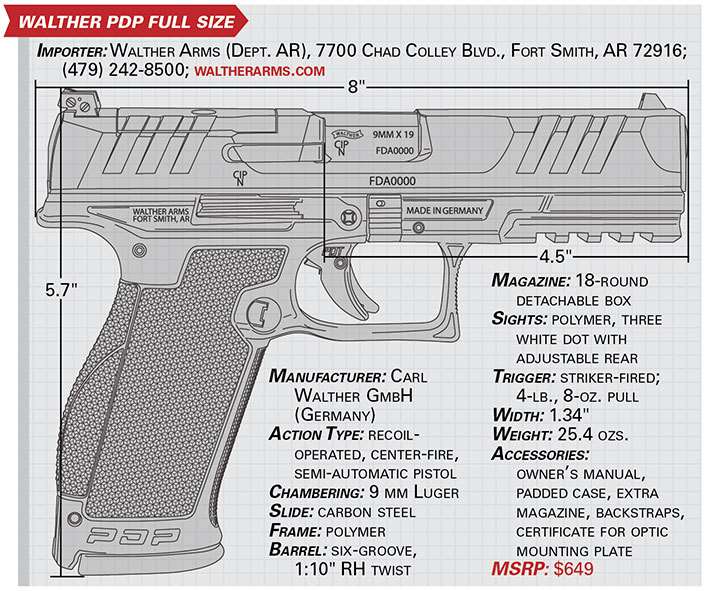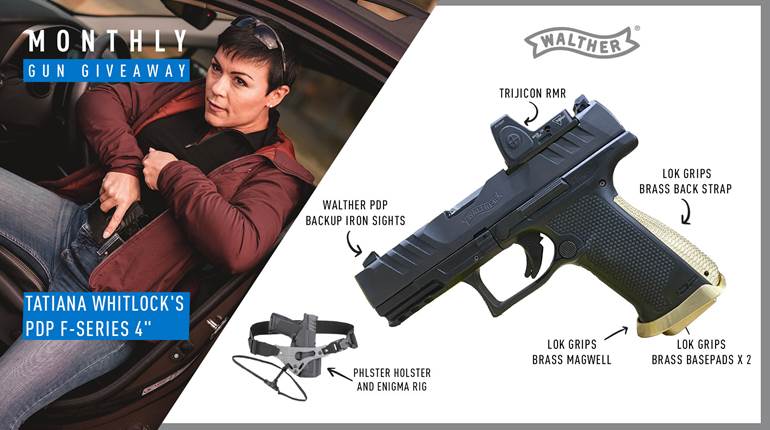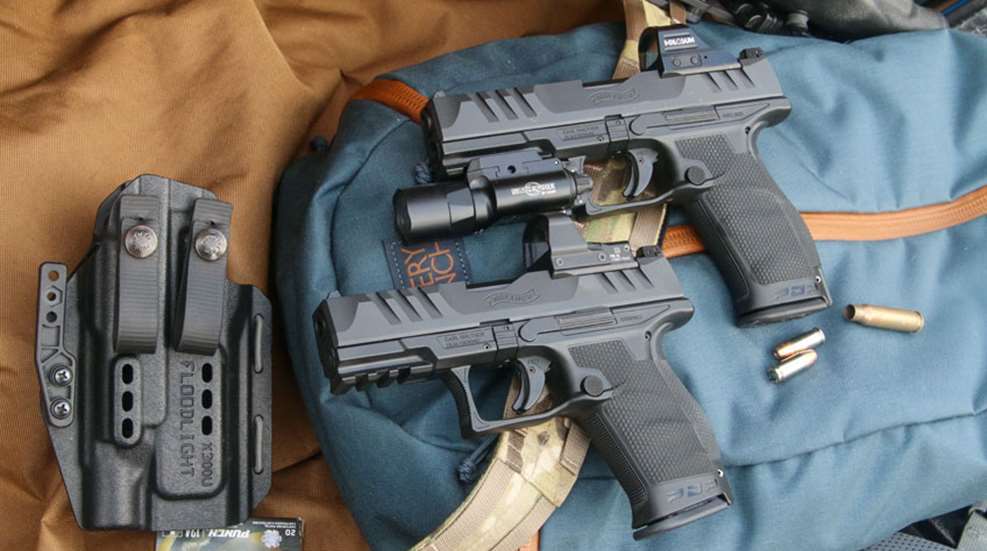
We are about 30 years into the polymer-frame, striker-fired semi-automatic handgun revolution. At this point, the generic word “pistol” more or less conjures an image of a handgun of this type. Although Walther has had a number of successful pistols in the genre, the Walther name is likely still anchored to mental images of the P38 or perhaps 007’s PPK. Walther’s new service pistol, however—the PDP—may be the flagship the company has needed to re-center that association.
The new Performance Duty Pistol line builds from the success of the PPQ line and the Q4/Q5 series. The PDPs are richly featured, optics-ready, 9 mm Luger service/defensive pistols available in Full Size and Compact models—the former with a 4.5" barrel and an 18-round magazine and the latter with a 4" barrel and a 15-round magazine.
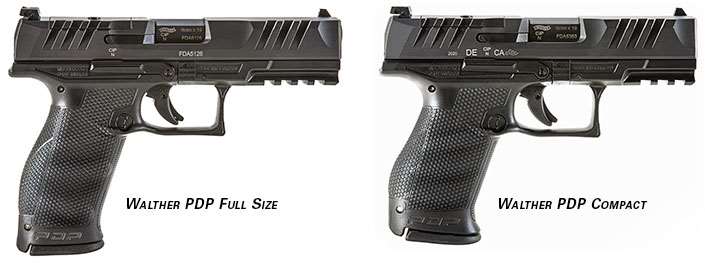
I attended a multi-day launch event where Walther introduced a small group of writers to the new pistols and had us shoot the PDPs in aggressive training blocks delivered by Walther Defense Division-sponsored trainers. We shot Leupold DeltaPoint Pro-equipped PDPs hard over several days—from concealment, on the move, under low light and night vision, from grounded/wounded scenarios, and much more. At the conclusion I had a great sense of the new pistols’ potential, and then spent another few months shooting them against my standard drills and training with them.
The short version is that the PDP appears to be an excellent addition to the market that will allow Walther to compete strongly against the established leaders. The standout features are a best-in-class trigger, excellent controls and exceptional accuracy. Visually, a shooter will likely cue in on the new grip texture and shape, as well as the slide’s shape/serrations.
The SuperTerrain serrations are a unique take on grasping grooves to manipulate the slide on the pistol. Whereas most pistol slides feature some type of shallow grooves or texturing, the PDP takes a quite different approach: carving the slide away to a sloped shape on either side of the SuperTerrain grooves which then “stand proud” with their more squared profile. The grooves within these prominent sections are themselves about 1/10" wide and 1/8" deep, giving the shooter a decidedly secure purchase with which to work the slide.
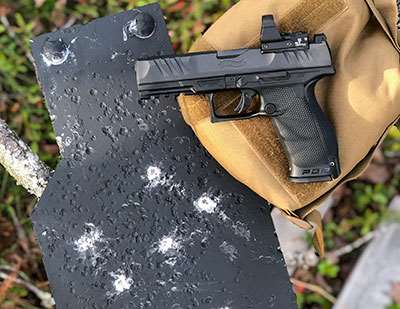
In casual visual comparison of the PDP and the PPQ series, the grip was second only to the serrations in grabbing my attention. The grip on the PDP is excellent in both feel and effective purchase. The frontstrap has molded-in checkering at about 25 lines per inch along its square, flat surface, transitioning into a forward curve at its base. The frontstrap’s square feel helps to center the gun and provide traction against recoil, while the curve helps pull the red dot on an optic into view as the shooter tightens his grip. The frontstrap is the only square to be found on the grip, with the backstrap and sides of the pistol being a complex and quite comfortable series of curves and radii. The PDP uses a series of three small “ripples” along either side of the grip that form subtle finger grooves where the digits wrap around.
The texturing on the grip frame is an attractive and aggressive three-dimensional pattern of miniature tetrahedrons that wraps around the sides and back. The texture locks the hand in nicely with minimal pressure and seems to function well when shooting with either sweaty hands or gloves. The texture is “politely” aggressive, so some carrying the PDP concealed against bare skin may feel the texture against their withers and find it to be slightly uncomfortable. I carried the PDP concealed at the appendix position inside the waistband using a PHLSTER floodlight holster (which fits a wide variety of pistols by indexing on an attached Surefire X300 light) and could feel the texturing a little more by day’s end but not painfully so.
The pistol is adjustable for size via three interchangeable backstraps, which are secured by a roll pin. The great majority of shooters will likely find the medium backstrap to be perfectly serviceable. I typically wear XL-sized gloves, and I shot extensively with both the medium and large backstraps in place on each pistol, and my XL-sized hands found both to be comfortable.
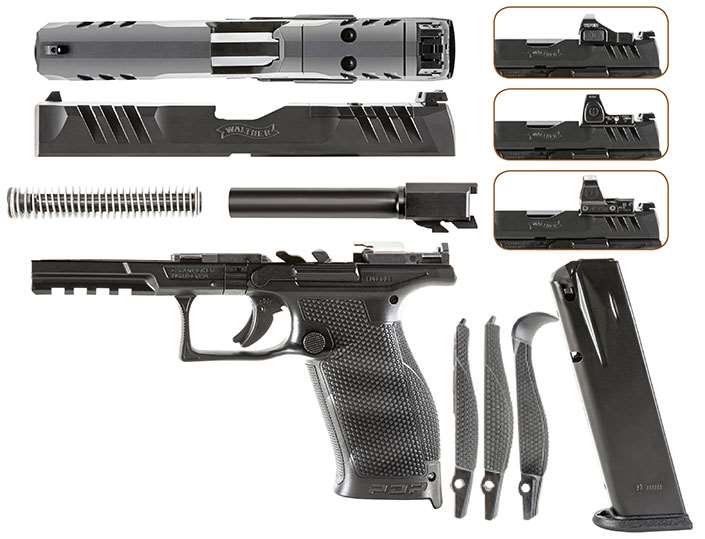
Handling
The PDP accommodates both left- and right-handed shooters with slide stops on each side of the pistol and a reversible magazine release. The controls are conveniently placed for each to be easily reached by the shooter’s firing-hand thumb. The magazine release is a large circular steel button with a checkered face. The PDP protects the magazine release from accidental activation by extending the undercut base of the trigger guard into a shelf ever so slightly longer than the release. The PDP compact runs on 15-round magazines, which are identical to and interchangeable with those used by the Walther PPQ. The fullsize model’s longer 18-rounders are a new magazine that will also work with the compact.
Walther deserves credit for the fine-tuned placement and effectiveness of the controls. On more than a few service pistol designs, the shooter may have to slightly re-arrange his two-handed firing grasp to prevent deactivation of the slide stop and/or inadvertent activation of an extended magazine release. This is pronounced with large shooters and certain pistols using an aggressively high, thumbs-forward grip, leading the shooter to either adjust to a less optimal grasp or accept the slide not locking back on an empty magazine. I fit into this camp with several popular pistols, yet had no issues at all with the PDP. At the launch event, this was one of the common high marks credited to the pistol by the group of writers and trainers. I saw no one have issues with the slide not locking back, while the reload speeds were impressive as a whole for a group unfamiliar with the new pistol. When it comes time to clean the pistol, the PDP allows the user to bypass the striker without having to press the trigger. Simply remove the magazine and lock the slide to the rear. A handcuff key or similarly sized punch can then be used to remove the backplate and the pistol can be taken down safely.
While you may be drawn to the PDP for its aforementioned thoughtful design and other reasons, it is the trigger that is likely to sell you. Those on both of the test pistols and each example I tried at the launch were uniformly superb. And not superb “for a striker-fired pistol” or any of the usual caveats applied in the genre, but simply superb against all comers.
Striker-fired trigger systems, in which the pistol lacks an additional manual safety, possess an inherent compression that manufacturers struggle to deal with. The trigger’s break must facilitate accurate shot placement while also providing a margin of safety against unintentional discharge. Some offerings, although they make excellent range or competition triggers, leave little margin for safety, while others complicate success on a difficult shot but are quite safe. Aristotle’s golden mean, were it applied to a defensive semi-automatic trigger, would likely result in one that allows the shooter to maximize his skill level yet still permit a rookie police officer to hold someone at gunpoint while a misunderstanding is sorted out. The PDP’s trigger may have reached that ideal compromise. There is a distinct take-up movement, and then the trigger engages a firm wall of resistance that the shooter rolls through a short, fairly crisp travel that ends predictably. Total weight is 5 lbs., 9 ozs. by specification, but my well-broken-in samples measured between 4 lbs., 8 ozs. and 5 lbs. of pressure.
I quite liked not only the trigger’s break but also the shape of the face of the trigger shoe. I found that I could engage the face with either the pad or joint of the trigger finger in a variety of ways and still get a nice press that moved the trigger straight to the rear. Many triggers are less forgiving and require a more distinct sweet spot to apply pressure.
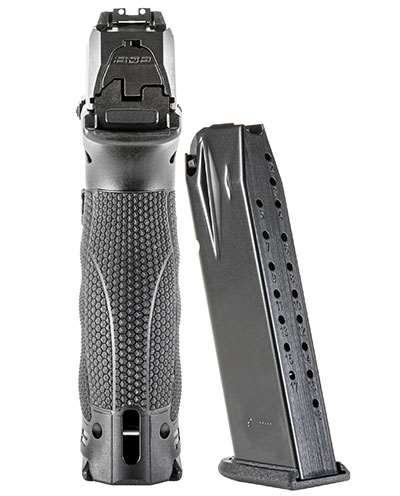
Details
The PDP uses a stepped chamber in its ramped barrel. The stepped chamber features a typical chamber dimension for most of its length before tapering to a final section that is at the tighter end of the specification. This feature has been utilized on designs intermittently going back as far as the Luger, and is intended to aid both reliability and accuracy. The fired brass from the PDP unmistakably shows the effect, leaving a distinct mark where the step occurs.
The stepped chamber provides a tight seal and is favorable to maximizing velocity potential from the cartridge. Walther representatives remarked that, in their testing of the new models, they routinely saw velocities akin to those of a barrel nearly an inch longer. As long as reliability is maintained, this is a free boost to short-barrel defensive ammunition, giving near +P velocity at standard pressures. My chronograph results did seem to show a marked boost in each load from the PDP’s respective barrel lengths, with the fullsize exceeding listed factory velocities for the loads and the shorter compact fully meeting them.
Whether the chamber or a variety of other factors, the PDPs were two of the most accurate service/carry pistols I’ve ever benched. Frankly, the results would have been impressive in semi-custom competition pistols at more than double the retail of the Walthers. For some time, I’ve thought the bar needs to be raised on precision from the striker-fired genre. In this respect the PDP really delivered. Across 30 five-shot groups, a full 27 of them measured under 2" at 25 yds.
I had the fullsize out at 100 yds. and wanted to see the bullet’s drop on one of my training accuracy loads. I kneeled and rested the Walther on a barricade and held at the top edge of a steel target. Even with the imperfect rest, six of six hollow points rung the steel and splattered into a well-centered, roughly 7" group that I could almost cover with an open hand.
The new Walther mounts optics using the now-familiar plate system, with several options sized to accommodate various optic footprints. Two screws mount the plate to the milled recess, and then the chosen optic (or a polymer cover plate for traditional front and rear sight use) is mounted to the adapter plate. The PDP mounting recess seems proportioned to present the optics in an ‘”integrated” manner; the optics come to the eye easily, with the normal-height backup sights just barely peeking into the bottom of the optic’s window. I used the Leupold DeltaPoint Pro primarily on the pistols, but also handled the PDPs with an Aimpoint ACRO, Trijicon SRO and Holosun 507c mounted.
Shooters wanting to use traditional sights will find an adjustable polymer rear and a polymer front in white-dot format. I dislike polymer sights as a rule, but appreciate that the savings here seems to have been passed onto the consumer in the PDP’s price. Walther wisely tapped into the diverse aftermarket for Glock sights and used the competitor’s rear dovetail dimension and screw-on front arrangement. Kudos to Walther for that decision; it is a concession that more makers should consider. Using Glock-pattern sights allows the shooter to be able to draw from the broadest set of choices available on the market.
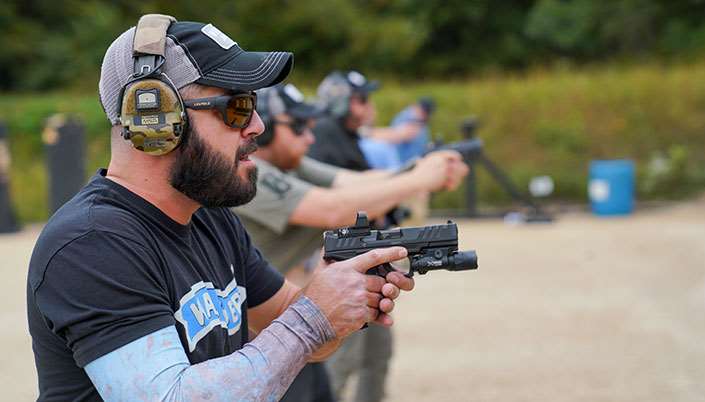
Performance
The PDP feature set “briefs well,” as the military saying goes. The question becomes how do the features come together in the hand and do they truly offer a compelling reason to switch from the many high-quality choices on the market? Sometimes a new model has one or two great features but, as the newness wears off, the shooter is left uninspired and drifts back toward market leaders or jumps onto the next new model. Those models that stick around and gain adherents tend to either have pole position in the market or have features that stack on top of one another in a complementary fashion, making them an extraordinary model for their time. The PDP effectively combines its features in a way that many shooters are going to appreciate.
In my testing, the flat front of the pistol’s grip allowed me to easily acquire it from the holster and helped lock it firmly and comfortably in my hand as I raised the dot to my line of sight. I was easily able to prep the trigger to its release point and cleanly press those last ounces while keeping the dot on target. The Walthers handled recoil well and returned reliably for follow-on shots. At the launch event while shooting demanding drills from the Defense Division trainers I was simply able to hit what I wanted as quickly as I was able without having to think much about it, which is not usually the case with an unfamiliar pistol. At times I credited the grip’s shape or texture, and, at other moments, the trigger was noticeable in being a seamless switch to achieve tough hits rather than a barrier to overcome. It wasn’t just me, either. During a night shoot, I watched as several of the shooters made strong-hand-only hits using a flashlight in the support hand to see reduced steel out to 40 yds.
After the event, I shot both pistols as extensively as the current ammunition shortage would allow, recording the results in the accompanying table. In short order, the pistols were establishing new bests in multiple standards for striker-fired pistols, and soon after were approaching or equaling personal bests established with some of my favorite pistols. A good example is ten shots slow fire from a two-handed hold onto a 25-yd. B8 bullseye. This is a drill where I had never squeaked out a perfect 100 with any striker-fired pistol; even ones that I shot well and competed with. There was always that maddening shot or two that got away. My very first 25-yd. target with the fullsize PDP was a 100, and the compact’s first was a tight 99 and the second was a 100. Since then, each pistol has added several more hundreds to its tally.
At speed and up close, the PDPs outran my normal times with poly/striker service guns. Whether 5-yd. roundups, FAST drills or 10-yd. plate racks, the Walthers were a step ahead of where I normally perform with similar pistols.
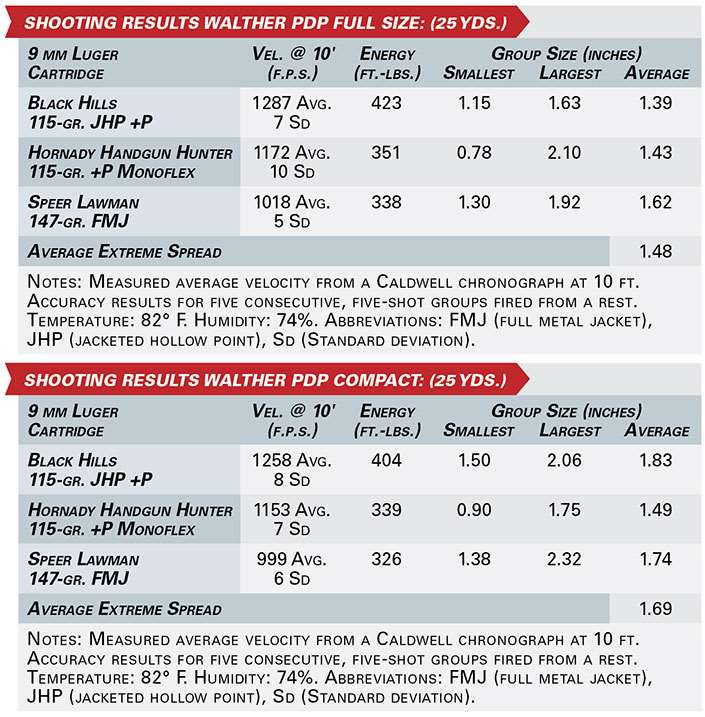
There is a small group of pistols that I am able to use to reliably shoot my best across both speed and accuracy when the challenge ramps up toward the edge of my ability. The PDP is now in that group; I don’t think there is a drill or shot that I could make with some particular favorites that I couldn’t hit equally well with the PDP. Such performance is entirely personal and subjective; however, if I had to make a difficult shot or drill standard with a polymer-frame, striker-fired semi-automatic, the PDP would be my current choice.
During testing, the pistols were 100 percent reliable. I have just over 1,300 rounds through the fullsize and about 1,200 downrange using the compact. The PDPs cycle with a smoothness and precision that suggest reliable function over the long term. It is too early to say definitively, but I noticed that there was little difference in the shooter’s perception of smoothness from when the pistols were freshly lubricated or rather dry. This is promising; some designs simply need more or more frequent lubrication while others shrug off neglect in that area.
I will watch with great interest as the PDPs enter the market. There is stiff competition from every maker and the market is brimming with very solid choices across makes and models—but I believe the new PDPs have the feature sets they need to help them gain a foothold with shooters.
